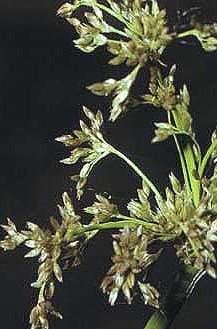Juncus roemerianus
| Juncus roemerianus | |
|---|---|

| |
| Scientific classification | |
| Kingdom: | Plantae |
| Clade: | Tracheophytes |
| Clade: | Angiosperms |
| Clade: | Monocots |
| Clade: | Commelinids |
| Order: | Poales |
| Family: | Juncaceae |
| Genus: | Juncus |
| Species: | J. roemerianus
|
| Binomial name | |
| Juncus roemerianus Scheele
| |
Juncus roemerianus is a species of flowering plant in the
Description
This rush is a perennial plant forming tufts of rough, rigid stems and leaves. It is gray-green in color. The plant may appear to be leafless at first glance, but what look like sharp-pointed stems are actually stiff leaves rolled tightly to form pointed cylinders. The true stems are tipped with inflorescences.[2] It grows from a rhizome. This plant is variable in appearance. Its size and shape depend on environmental conditions in its salt marsh habitat. In areas with low soil salinity, the plant can exceed two meters in height, whereas in high-salinity areas the rush is dwarfed, sometimes measuring under 30 centimeters (12 in.) tall. Both large and small plants generally occur in one marsh, with the large plants nearest the open water and the small plants occurring on higher ground in the salt flats and other areas of higher salinity.[1] Plants of different sizes differ genetically, as well, with soil salinity being the selective force leading to the genetic variation. The dwarf plants have an adaptation to high soil salinity. Larger plants lack this adaptation, and do not survive when experimentally transplanted to high-salinity environments.[3]
Reproduction
The plant reproduces
Ecology
This is a common and ecologically important plant in its range, often
Other plants occurring in the higher-salinity regions of the marsh include
This rush provides cover for a number of salt marsh animal species. Birds such as the
Potential uses
This plant has shown potential as an agent of phytoremediation after oil spills. When it grows in sediments polluted with diesel fuel it reduces the concentration of total petroleum hydrocarbons, polycyclic aromatic hydrocarbons, and n-alkanes in the sediments.[11]
Chemistry
Juncusol is a 9,10-dihydrophenathrene derivative found in J. roemerianus.[12][13]
References
- ^ a b c d e Uchytil, Ronald J. (1992). Juncus roemerianus. In: Fire Effects Information System, [Online]. U.S. Department of Agriculture, Forest Service, Rocky Mountain Research Station, Fire Sciences Laboratory. Retrieved 1-2-2012.
- ^ Juncus roemerianus. University of Florida IFAS Center for Aquatic and Invasive Plants. Retrieved 1-2-2012.
- ^ Eleuterius, L. N. (1989). Natural selection and genetic adaptation to hypersalinity in Juncus roemerianus Scheele. Aquatic Botany 36(1) 45-53. Retrieved 1-2-2012.
- ^ Christian, R. R., et al. (1990). Juncus roemerianus production and decomposition along gradients of salinity and hydroperiod. Marine Ecology Progress Series 68 137-45. Retrieved 1-2-2012.
- ^ Biber, P. and J. D. Caldwell. Regional Native Plant Nursery for Habitat Restoration. University of Southern Mississippi Gulf Coast Research Laboratory. Retrieved 1-2-2012.
- ^ Woerner, L. S. and C. T. Hackney. (1997). Distribution of Juncus roemerianus in North Carolina tidal marshes: The importance of physical and biotic variables. Wetlands 17(2) 284-91.
- ^ Touchette, B. W., et al. (2009). Tolerance and avoidance: Two contrasting physiological responses to salt stress in mature marsh halophytes Juncus roemerianus Scheele and Spartina alterniflora Loisel Archived 2012-04-24 at the Wayback Machine Journal of Experimental Marine Biology and Ecology 380(1-2) 106-12. Retrieved 1-2-2012.
- ^ a b Kohlmeyer, J.; Volkmann-Kohlmeyer, B.; Eriksson, O.E. (1996). "Fungi on Juncus roemerianus. New marine and terrestrial ascomycetes". Mycological Research. 100: 393-404. Retrieved 16 July 2023.
- ^ Kohlmeyer, J.; Volkmann-Kohlmeyer, B.; Eriksson, O.E. (1997). "Fungi on Juncus roemerianus. 9. New obligate and facultative marine ascomycotina". Botanica Marina. 40: 291-300.
- ^ "adarca :: Marine Fungi". marinefungi.org. Retrieved 16 July 2023.
- ^ Lin, Q. and I. A. Mendelssohn. (2009). Potential of restoration and phytoremediation with Juncus roemerianus for diesel-contaminated coastal wetlands. Ecological Engineering 35 85-91. Retrieved 1-2-2012.
- PMID 830696

